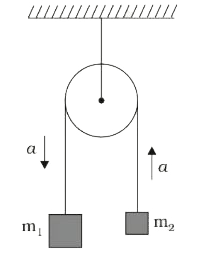A body A of mass M while falling vertically downwards under gravity breaks into two parts: a body B of mass 13M and a body C of mass 23M The centre of mass of bodies B and C taken together shifts compared to that of body A towards
depends on height of breaking
does not shift
shift towards body C
shift towards body B
The correct Answer is:B
Before breaking, the centre of mass of system is moving under gravity. Thus, acceleration of the centre of mass is gravitational acceleration. During breaking, internal force comes into play which are not responsible for the acceleration of the centre of mass.
This inducates that, the acceleration of centre of mass remains the same (equal to gravitational acceleration). thus, the center of mass of system continues its original path.
Topper's Solved these Questions
Similar Questions
A body A of mass M while falling wertically downwards under gravity brakes into two parts, a body B of mass 13 M and a body C of mass 23 M. The center of mass of bodies B and C taken together shifts compared to that of body A towards
View SolutionA body falling vertically downwards under gravity breaks in two parts of unequal masses. The centre of mass of the two parts taken together shifts horizontally towards
View Solution
Knowledge Check
The centre of mass of a body
Alies always at the geometrical centreBlies always inside the bodyClies always outside the bodyDmay lie within or outside the bodyA body of mass 100 kg and density 500 kg m−3 floats in water. The additional mass should be added to the body so that the body will shink is
A80 kgB100 kgC150 kgD200 kg
A body falling vertically downwards under gravity breaks in two parts of unequal masses. The centre of mass of the two parts taken together shifts horizontally towards
View SolutionCan the centre of mass of a body be at a point outside the body?
View SolutionTwo bodies of masses m1andm2(<m1) are connected to the ends of a massless cord and allowed to move as shown in figure. The pulley is both massless and frictionless. The acceleration of the centre of mass is (m1−m2)n(m1+m2)2g. Find the value of n.

View SolutionThe centre of mass of an extended body on the surface of the earth and its centre of gravity
View SolutionA body A mass m1 exerts a force on another body B of mass m2 . If the acceleration of B be a2 , then the acceleration (in magnitude) of A is
View SolutionPoint C is the centre of mass of the rigid body shown in figure. Find the total torque acting on the body about point C.

View Solution
